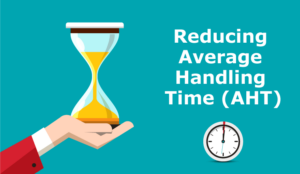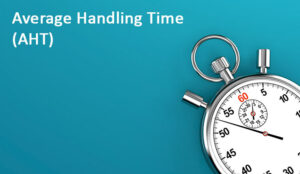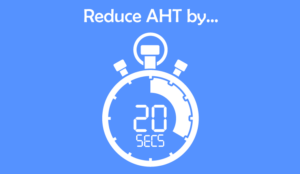Carolyn Blunt helps you to determine whether you have the right approach to reducing AHT.
So much is said and written about the average handling time (AHT) metric and the implications of using AHT in your contact centre.
Some people really stand by it and others want to get rid of this altogether, believing we should let each call ‘take as long as it takes’ so that it provides a personalised customer experience.
However, for call centre planning purposes, I bet someone is still crunching those numbers and planning shifts and schedules on it.
Taking your eye off the metric altogether is like working blind and you will get caught out by spikes in your call volumes and cause customers to have overly long wait times.
So, rather than join the old debate, let’s think instead about the following 3 questions:
1. Why do you want to reduce AHT?
Sure, it would mean your ‘cost to serve’ per customer would be reduced. Your contact centre could handle more calls with the same number of staff. Your productivity and efficiency would increase, thereby reducing costs and maximising profitability.
This, of course, is essential for staying in business! But dig deeper. What other reasons might you have for wanting to reduce AHT? Be really honest. Write them down.
Now look at the list and consider this question. Do those reasons truly serve your customers? Or do those reasons serve your organisation more?
2. What would be the impact on customer experience or sales opportunities if you were to reduce AHT?
What is causing the longer calls? Would removing this diminish the customer experience? Would it reduce the opportunities for your agents to build rapport and make customers feel special, and therefore cause customers to feel less loyal to your organisation?

Carolyn Blunt
Would it simply cause them to call back again another time and therefore be a false economy? If you have done thorough statistical analysis and know this is not the case, then great!
Reducing AHT can improve the customer experience if your longer call times are caused by under-skilled agents putting them on hold for long periods or by disjointed processes that mean agents have to call another part of your organisation or, even worse, outside it, to get answers.
But just be really clear on where you are taking the duration from and whether this is good or bad time in your calls.
3. Why would your agents be motivated to reduce AHT?
If you are thinking about reducing the ‘general chit-chat’ that happens between customers and some agents, then think about it from an agent’s point of view. This may be one of the most enjoyable parts of the job (especially if they are an extrovert ‘people’ person).
Taking this away not only risks your customer loyalty, as we have already discussed, but can also cause expensive churn if your agents get bored of being too robotic and leave.
You may have set out to reduce AHT but now you are spending time recruiting and interviewing.
Be sure to make the connection!
Alternatively, if your agents are on board with your desire to change the style of calls, then you must support them with specific, practical training sessions.
Taking your agents off the phones for a ‘Power Hour’ and facilitating practical tips to reduce AHT, as well as playing them example calls where there is an opportunity to reduce the time, is key to the success of any plan to reduce AHT. Getting them to discuss HOW they would have shortened the call and taking that specific action away with them is vital.
Follow up with plenty of support from your coaches and team leaders to ensure that these action plans are implemented.
Finally, consider your systems and your use of technology. Having a slick but simple IVR, skills-based routing and detailed reports of your calls with interaction analytics will all help you to get the win:win of reducing AHT and improving the customer experience.
If you’d like to know more, I’ve made an e-masterclass video on Reducing Average Handling Time, where I share the answers for reducing AHT behind the scenes.
It covers 4 ways you can support agents to reduce average handling time while they’re on the phones.
Click here for our 49 Tips for Reducing Average Handling Time
Carolyn Blunt is Managing Director of Real Results Training and co-author of ‘Delivering Effective Social Customer Service’.
Author: Jonty Pearce
Published On: 11th Dec 2013 - Last modified: 13th Jan 2025
Read more about - Customer Service Strategy, Average Handling Time (AHT), Call Handling, Carolyn Blunt




































There is a big difference between ‘reducing AHT’ as an absolute, and ‘optimizing AHT’ that considers both productivity and customer perspective. Pitting ‘quality’ and ‘efficiency’ against one another is not a constructive argument. AHT is integral to planning for effective service level -without is ASA would become highly unpredictable, and answering the phone in the first instance may be the biggest quality indicator of all. Also, some agents are more productive (without loss of quality) than others; if AHT were not a consideration to reward productive performance there would be no incentive for agents to strive for being productive – which would be a loss to the organization.
Great balanced article Carolyn. Good consideration of the impact of what drastic AHT measures can do to overall customer experience.
Thanks,
Nick
To add to the topic, remember that when we talk about AHT, we are talking about 3 metrics; Talk Time , After Call Work and Hold. To better understand the causes of high / low AHT you may want to analize the 3 component